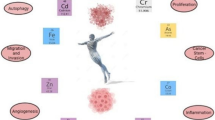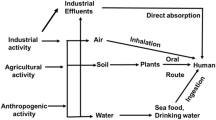Abstract
Acute and chronic exposure to cadmium can cause numerous health effects including poisoning, as well as, bone, liver, and kidney diseases. Cadmium competes with iron absorption in blood and can induce anemia. Cadmium body burden can be measured through urine and blood samples. Urine reflects chronic and blood indicates recent and cumulative exposures to cadmium. Dietary is considered as the main source of exposure to cadmium in non-smoking general population. The study was conducted to determine cadmium level in blood, urine, and in diet of 120 non-smoking adults in Tehran. Dietary components and consumption pattern of participants estimated by a food frequency questionnaire. Next, the correlation investigated between them. Moreover, serum ferritin measured as a marker of iron storage in blood to determine its association with cadmium. The prediction of cadmium fate in the body is determined by toxicokinetic models. This study tried to evaluate one of these models’ validity which is developed to predict urinary cadmium from dietary. Afterwards, the predicted urinary compared with the measured urinary cadmium. The correlation coefficient between dietary and blood cadmium equaled 0.66 which was statically significant, but the correlation between dietary and urinary cadmium was minimal and not statically significant (p > 0.05). An inverse and negative correlation was found between serum ferritin and blood cadmium. The mean predicted urinary cadmium calculated by the model was 2.5-fold higher than the measured value in the total population. Results of the present study revealed that blood cadmium reflected mainly acute exposure. There was no correlation between chronic and acute exposures to cadmium. The low serum ferritin level increased cadmium amount in blood. Moreover, the mean predicted urinary cadmium by the model was greater than the measured value. It can because of characteristics of populations and type of dietary exposure. Thus, it is suggested that the model coefficients are determined in each society based on their characteristics.




Similar content being viewed by others
References
He P, Lu Y, Liang Y, Chen B, Wu M, Li S, He G, Jin T (2013) Exposure assessment of dietary cadmium: findings from Shanghainese over 40 years, China. BMC Public Health 13(1):590
Wiseman CLS, Parnia A, Chakravartty D, Archbold J, Zawar N, Copes R, Cole DC (2017) Blood cadmium concentrations and environmental exposure sources in newcomer South and East Asian women in the Greater Toronto Area, Canada. Environ Res 154(Supplement C):19–27. https://doi.org/10.1016/j.envres.2016.12.013
Järup L, Åkesson A (2009) Current status of cadmium as an environmental health problem. Toxicol Appl Pharmacol 238(3):201–208. https://doi.org/10.1016/j.taap.2009.04.020
Julin B, Vahter M, Amzal B, Wolk A, Berglund M, Åkesson A (2011) Relation between dietary cadmium intake and biomarkers of cadmium exposure in premenopausal women accounting for body iron stores. Environ Health 10(1):1
Song Y, Wang Y, Mao W, Sui H, Yong L, Yang D, Jiang D, Zhang L, Gong Y (2017) Dietary cadmium exposure assessment among the Chinese population. PLoS One 12(5):e0177978
Satarug S, Vesey DA, Gobe GC (2017) Current health risk assessment practice for dietary cadmium: data from different countries. Food Chem Toxicol 106:430–445
Amzal B, Julin B, Vahter M, Wolk A, Johanson G, Akesson A (2009) Population toxicokinetic modeling of cadmium for health risk assessment. Environ Health Perspect 117(8):1293–1301
Hays SM, Nordberg M, Yager JW, Aylward LL (2008) Biomonitoring equivalents (BE) dossier for cadmium (Cd)(CAS No. 7440-43-9). Regul Toxicol Pharmacol 51(3):S49–S56
Ahn B, Kim S-H, Park M-J (2017) Blood cadmium concentrations in Korean adolescents: from the Korea National Health and Nutrition Examination Survey 2010–2013. Int J Hyg Environ Health 220(1):37–42. https://doi.org/10.1016/j.ijheh.2016.10.003
EFSA (2009) Scientific opinion of the panel on contaminants in the food chain on a request from the European Commission on cadmium in food. EFSA J 980:1–139
FAO/WHO (2011) Joint FAO/WHO food standards programme. CODEX Committee on Contaminants in Foods, Fifth Session, The Hague, The Netherlands
Bernillon P, Bois FY (2000) Statistical issues in toxicokinetic modeling: a Bayesian perspective. Environ Health Perspect 108:883–893
Satarug S, Swaddiwudhipong W, Ruangyuttikarn W, Nishijo M, Ruiz P (2013) Modeling cadmium exposures in low-and high-exposure areas in Thailand. Environ Health Perspect 121(5):531–536
Satarug S, Ujjin P, Vanavanitkun Y, Baker JR, Moore MR (2004) Influence of body iron store status and cigarette smoking on cadmium body burden of healthy Thai women and men. Toxicol Lett 148(3):177–185
Kippler M, Ekström E-C, Lönnerdal B, Goessler W, Åkesson A, El Arifeen S, Persson L-Å, Vahter M (2007) Influence of iron and zinc status on cadmium accumulation in Bangladeshi women. Toxicol Appl Pharmacol 222(2):221–226
Ghoochani M, Rastkari N, Yunesian M, Nodehi RN, Mesdaghinia A, Houshiarrad A, Shamsipour M, Dehghani MH (2018) What do we know about exposure of Iranians to cadmium? Findings from a systematic review. Environ Sci Pollut Res 25(2):1–11
Moosavi A, Ardekani AM (2017) The frequency and importance of common α-globin gene deletions among β-thalassemia carriers in an Iranian population. Avicenna J Med Biotechnol 9(4):196–200
Najafi I, Shakeri R, Islami F, Malekzadeh F, Salahi R, Yapan-Gharavi M, Hosseini M, Hakemi M, Alatab S, Rahmati A (2012) Prevalence of chronic kidney disease and its associated risk factors: the first report from Iran using both microalbuminuria and urine sediment. Arch Iran Med 15(2):70–75
Tang S, Yu X, Wu C (2016) Comparison of the levels of five heavy metals in human urine and sweat after strenuous exercise by ICP-MS. JMPA 4(02):183–188
Massadeh A, Gharibeh A, Omari K, Al-Momani I, Alomari A, Tumah H, Hayajneh W (2010) Simultaneous determination of Cd, Pb, Cu, Zn, and Se in human blood of Jordanian smokers by ICP-OES. Biol Trace Elem Res 133(1):1–11
Nasreddine L, Nashalian O, Naja F, Itani L, Parent-Massin D, Nabhani-Zeidan M, Hwalla N (2010) Dietary exposure to essential and toxic trace elements from a Total diet study in an adult Lebanese urban population. Food Chem Toxicol 48(5):1262–1269. https://doi.org/10.1016/j.fct.2010.02.020
Zhao D, Liu R-Y, Xiang P, Juhasz AL, Huang L, Luo J, Li H-B, Ma LQ (2017) Applying cadmium relative bioavailability to assess dietary intake from rice to predict cadmium urinary excretion in nonsmokers. Environ Sci Technol 51(12):6756–6764
Ishizaki M, Suwazono Y, Kido T, Nishijo M, Honda R, Kobayashi E, Nogawa K, Nakagawa H (2015) Estimation of biological half-life of urinary cadmium in inhabitants after cessation of environmental cadmium pollution using a mixed linear model. Food Addit Contam A 32(8):1273–1276
Ikeda M, Nakatsuka H, Watanabe T, Shimbo S (2015) Estimation of daily cadmium intake from cadmium in blood or cadmium in urine. Environ Health Prev Med 20(6):455–459
Shimbo S, Zhang Z-W, Moon C-S, Watanabe T, Nakatsuka H, Matsuda-Inoguchi N, Higashikawa K, Ikeda M (2000) Correlation between urine and blood concentrations, and dietary intake of cadmium and lead among women in the general population of Japan. Int Arch Occup Environ Health 73(3):163–170
Vacchi-Suzzi C, Eriksen KT, Levine K, McElroy J, Tjønneland A, Raaschou-Nielsen O, Harrington JM, Meliker JR (2015) Dietary intake estimates and urinary cadmium levels in Danish postmenopausal women. PLoS One 10(9):e0138784
Moon C-S, Paik J-M, Choi C-S, Kim D-H, Ikeda M (2003) Lead and cadmium levels in daily foods, blood and urine in children and their mothers in Korea. Int Arch Occup Environ Health 76(4):282–288
Quraishi SM, Adams SV, Shafer M, Meliker JR, Li W, Luo J, Neuhouser ML, Newcomb PA (2015) Urinary cadmium and estimated dietary cadmium in the Women’s Health Initiative. J Expo Sci Environ Epidemiol 26:303–308
Moon C-S, Zhang Z-W, Shimbo S, Watanabe T, Moon D-H, Lee C-U, B-k L, Ahn K-D, Lee S-H, Ikeda M (1998) Evaluation of urinary cadmium and lead as markers of background exposure of middle-aged women in Korea. Int Arch Occup Environ Health 71(4):251–256
Sun H, Wang D, Zhou Z, Ding Z, Chen X, Xu Y, Huang L, Tang D (2016) Association of cadmium in urine and blood with age in a general population with low environmental exposure. Chemosphere 156:392–397
Acknowledgements
The authors are grateful to the staff at the laboratory of the Department of Environmental Health Engineering, Tehran University of Medical Sciences. We also thank the staff at the Occupational Medicine Clinic and the laboratory of Baharloo Hospital.
Funding Sources
This study was conducted as part of the Ph.D. dissertation of the first author, supported by the Institute for Environmental Research (IER), Tehran University of Medical Sciences, under grant number 96-02-46-34989.
Author information
Authors and Affiliations
Corresponding authors
Ethics declarations
This study was approved by the Ethics Committee, Tehran University of Medical Sciences (Code: IR.TUMS.VCR.REC.1397.280).
Conflict of Interest
The authors declare that they have no conflict of interest.
Additional information
Publisher’s Note
Springer Nature remains neutral with regard to jurisdictional claims in published maps and institutional affiliations.
Rights and permissions
About this article
Cite this article
Ghoochani, M., Dehghani, M.H., Rastkari, N. et al. Association Among Sources Exposure of Cadmium in the Adult Non-smoking General Population of Tehran. Biol Trace Elem Res 191, 27–33 (2019). https://doi.org/10.1007/s12011-018-1590-9
Received:
Accepted:
Published:
Issue Date:
DOI: https://doi.org/10.1007/s12011-018-1590-9




